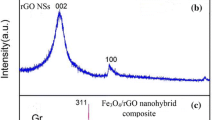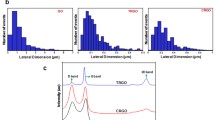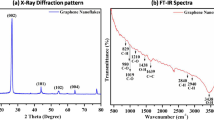Abstract
Graphene and its derivatives are increasingly applied in nanoelectronics, biosensing, drug delivery, and biomedical applications. However, the information about its cytotoxicity remains limited. Herein, the distribution and cytotoxicity of graphene oxide (GO) and TiO2-graphene oxide composite (TiO2-GO composite) were evaluated in A549 cells. Cell viability and cell ultrastructure were measured. Our results indicated that GO could enter A549 cells and located in the cytoplasm and nucleus without causing any cell damage. TiO2 nanoparticles and GO would be separated after TiO2-GO composite entered A549 cells. TiO2-GO composite could induce cytotoxicity similar to TiO2 nanoparticles, which was probably attributed to oxidative stress. These results should be considered in the development of biological applications of GO and TiO2-GO composite.




Similar content being viewed by others
References
Li D, Kaner RB (2008) Graphene-based materials. Nat Nanotechnol 3:101
Park S, Lee KS, Bozoklu G, Cai W, Nguyen ST, Ruoff RS (2008) Graphene oxide papers modified by divalent ions-enhancing mechanical properties via chemical cross-linking. ACS Nano 2(3):572–578
Geim AK (2009) Graphene: status and prospects. Science 324(5934):1530–1534
Allen MJ, Tung VC, Kaner RB (2009) Honeycomb carbon: a review of graphene. Chem Rev 110(1):132–145
Guo S, Dong S, Wang E (2009) Three-dimensional Pt-on-Pd bimetallic nanodendrites supported on graphene nanosheet: facile synthesis and used as an advanced nanoelectrocatalyst for methanol oxidation. ACS Nano 4(1):547–555
Hu W, Peng C, Luo W, Lv M, Li X, Li D, Huang Q, Fan C (2010) Graphene-based antibacterial paper. ACS Nano 4(7):4317–4323
Akhavan O, Ghaderi E (2009) Photocatalytic reduction of graphene oxide nanosheets on TiO2 thin film for photoinactivation of bacteria in solar light irradiation. J Phys Chem C 113(47):20214–20220
Sun X, Liu Z, Welsher K, Robinson JT, Goodwin A, Zaric S, Dai H (2008) Nano-graphene oxide for cellular imaging and drug delivery. Nano Res 1(3):203–212
Chang Y, Yang ST, Liu JH, Dong E, Wang Y, Cao A, Liu Y, Wang H (2011) In vitro toxicity evaluation of graphene oxide on A549 cells. Toxicol Lett 200(3):201–210
Akhavan O, Ghaderi E (2010) Toxicity of graphene and graphene oxide nanowalls against bacteria. ACS Nano 4(10):5731–5736
Kovtyukhova NI, Ollivier PJ, Martin BR, Mallouk TE, Chizhik SA, Buzaneva EV, Gorchinskiy AD (1999) Layer-by-layer assembly of ultrathin composite films from micron-sized graphite oxide sheets and polycations. Chem Mater 11(3):771–778
Cote LJ, Kim F, Huang J (2008) Langmuir-Blodgett assembly of graphite oxide single layers. J Am Chem Soc 131(3):1043–1049
Lieber M, Todaro G, Smith B, Szakal A, Nelson-Rees W (1976) A continuous tumor‐cell line from a human lung carcinoma with properties of type II alveolar epithelial cells. Int J Cancer 17(1):62–70
Foster KA, Oster CG, Mayer MM, Avery ML, Audus KL (1998) Characterization of the A549 cell line as a type II pulmonary epithelial cell model for drug metabolism. Exp Cell Res 243(2):359–366
Davoren M, Herzog E, Casey A, Cottineau B, Chambers G, Byrne HJ, Lyng FM (2007) In vitro toxicity evaluation of single walled carbon nanotubes on human A549 lung cells. Toxicol In Vitro 21(3):438–448
Foldbjerg R, Dang DA, Autrup H (2011) Cytotoxicity and genotoxicity of silver nanoparticles in the human lung cancer cell line, A549. Arch Toxicol 85(7):743–750
Tang Y, Wang F, Jin C, Liang H, Zhong X, Yang Y (2013) Mitochondrial injury induced by nanosized titanium dioxide in A549 cells and rats. Environ Toxicol Pharmacol 36(1):66–72
Wilhelm C, Billotey C, Roger J, Pons J, Bacri JC, Gazeau F (2003) Intracellular uptake of anionic superparamagnetic nanoparticles as a function of their surface coating. Biomaterials 24(6):1001–1011
Gupta AK, Berry C, Gupta M, Curtis A (2003) Receptor-mediated targeting of magnetic nanoparticles using insulin as a surface ligand to prevent endocytosis. IEEE Trans Nanobioscience 2(4):255–261
Kim JS, Yoon TJ, Yu KN, Noh MS, Woo M, Kim BG, Lee KH, Sohn BH, Park SB, Lee JK (2006) Cellular uptake of magnetic nanoparticle is mediated through energy-dependent endocytosis in A549 cells. J Vet Sci 7(4):321–326
Wang JJ, Sanderson BJ, Wang H (2007) Cyto- and genotoxicity of ultrafine TiO2 particles in cultured human lymphoblastoid cells. Mutat Res 628(2):99–106
Tröger L, Yokoyama T, Arvanitis D, Lederer T, Tischer M, Baberschke K (1994) Determination of bond lengths, atomic mean-square relative displacements, and local thermal expansion by means of soft-X-ray photoabsorption. Phys Rev B Condens Matter 49(2):888–903
Gupta AK, Gupta M (2005) Cytotoxicity suppression and cellular uptake enhancement of surface modified magnetic nanoparticles. Biomaterials 26(13):1565–1573
Yang D, Velamakanni A, Bozoklu G, Park S, Stoller M, Piner RD, Stankovich S, Jung I, Field DA, Ventrice CA Jr (2009) Chemical analysis of graphene oxide films after heat and chemical treatments by X-ray photoelectron and Micro-Raman spectroscopy. Carbon 47(1):145–152
Compagnini G, Giannazzo F, Sonde S, Raineri V, Rimini E (2009) Ion irradiation and defect formation in single layer graphene. Carbon 47(14):3201–3207
Li W, Chen C, Ye C, Wei T, Zhao Y, Lao F, Chen Z, Meng H, Gao Y, Yuan H (2008) The translocation of fullerenic nanoparticles into lysosome via the pathway of clathrin-mediated endocytosis. Nanotechnology 19(14):145102
Dreyer DR, Park S, Bielawski CW, Ruoff RS (2010) The chemistry of graphene oxide. Chem Soc Rev 39(1):228–240
Geim AK, Novoselov KS (2007) The rise of graphene. Nat Mater 6(3):183–191
Kim KT, Klaine SJ, Cho J, Kim S-H, Kim SD (2010) Oxidative stress responses of Daphnia magna exposed to TiO2 nanoparticles according to size fraction. Sci Total Environ 408(10):2268–2272
Mocan T, Clichici S, Agoşton-Coldea L, Mocan L, Şimon Ş, Ilie I, Biriş A, Mureşan A (2010) Implications of oxidative stress mechanisms in toxicity of nanoparticles (review). Acta Physiol Hung 97(3):247–255
Jin C, Tang Y, Yang FG, Li XL, Xu S, Fan XY, Huang YY, Yang YJ (2011) Cellular toxicity of TiO2 nanoparticles in anatase and rutile crystal phase. Biol Trace Elem Res 141(1–3):3–15
Li N, Ma L, Wang J, Zheng L, Liu J, Duan Y, Liu H, Zhao X, Wang S, Wang H (2010) Interaction between nano-anatase TiO2 and liver DNA from mice in vivo. Nanoscale Res Lett 5(1):108–115
Acknowledgments
This work was supported by the State Key Development Program for Basic Research of China (Grant No. 2011CB932800), National Public Benefit Research Sector of China (Grant No. 201210284-02), National Natural Science Foundation of China (Grant No. 11105221), and Youth Foundation of Second Military Medical University (Grant No. 2010QN02).
Conflict of Interest Statement
The authors declare that there are no conflicts of interest.
Author information
Authors and Affiliations
Corresponding author
Rights and permissions
About this article
Cite this article
Jin, C., Wang, F., Tang, Y. et al. Distribution of Graphene Oxide and TiO2-Graphene Oxide Composite in A549 Cells. Biol Trace Elem Res 159, 393–398 (2014). https://doi.org/10.1007/s12011-014-0027-3
Received:
Accepted:
Published:
Issue Date:
DOI: https://doi.org/10.1007/s12011-014-0027-3




